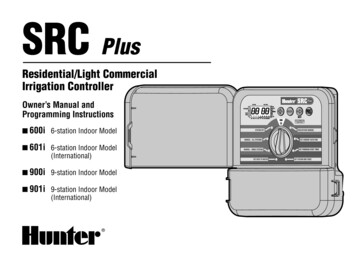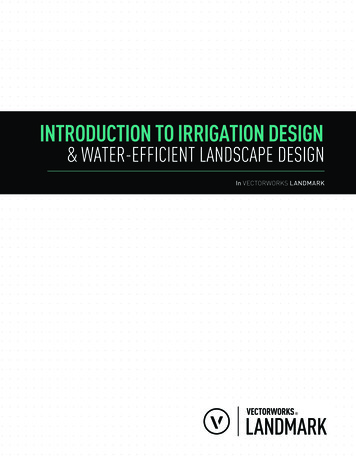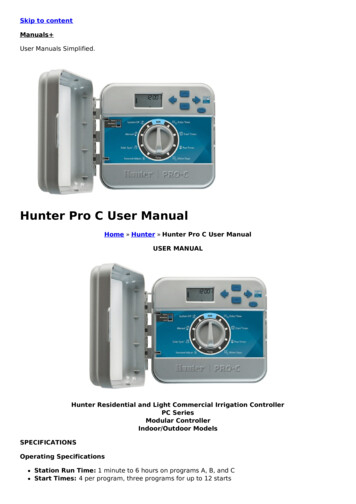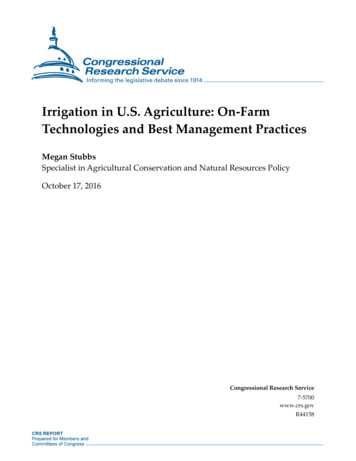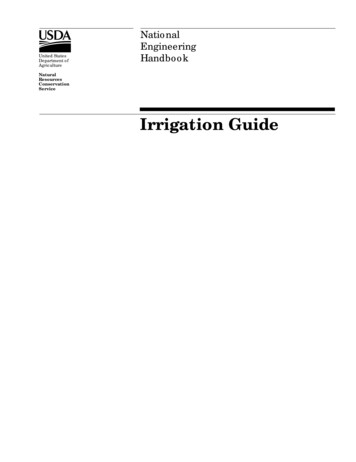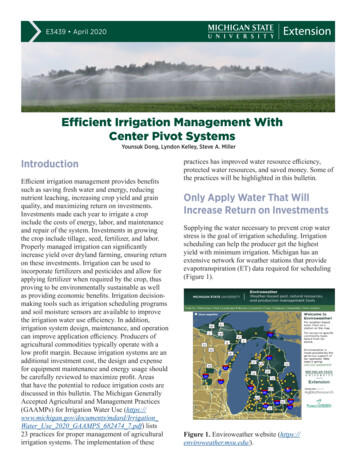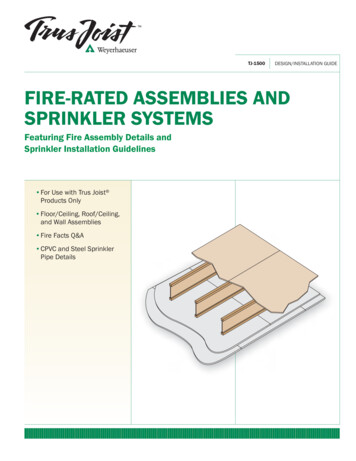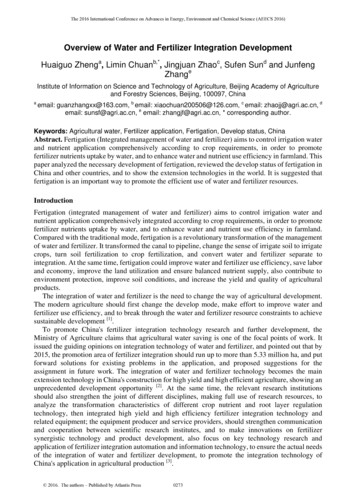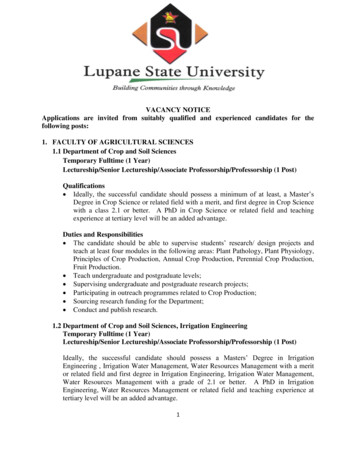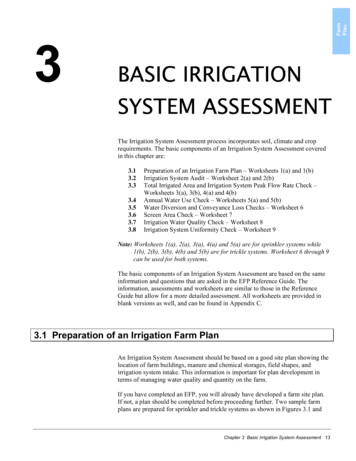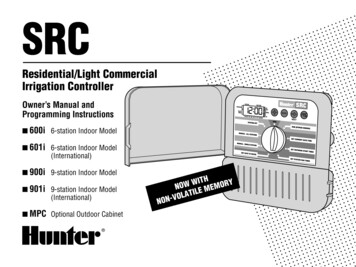
Transcription
SRCResidential/Light CommercialIrrigation ControllerOwner’s Manual andProgramming Instructions 600i 6-station Indoor Model 601i 6-station Indoor Model(International) 900i 9-station Indoor Model 901i 9-station Indoor Model(International) MPC Optional Outdoor Cabinet NYWITHNOW E MEMORILOLATVNO
2
TABLE OF CONTENTS .INTRODUCTION AND INSTALLATIONIntroduction . 1SRC Components.2-3Mounting Controller to Wall . 4Mounting the Controller Outdoors (MPC). 5Connecting Valves and Transformer. 6Connecting the Battery. 7Connecting a Master Valve . 7Connecting a Pump Start Relay . 8Connecting a Weather Sensor . 9Connecting a SRR or ICR Remote Control. 11Connecting to IMMS Central Control System . 11Power Failures. 11CONTROLLER PROGRAMMING AND OPERATIONSprinkler System Fundamentals . 12Programming Fundamentals. 13Creating a Watering Schedule. 14How to Fill Out the Watering Schedule Form . 14Watering Schedule Form . 15Programming the ControllerSetting the Date and Time . 16Setting Watering Start Times. 17Eliminating a Program Start Time . 173
TABLE OF CONTENTS (Continued) .Programming the ControllerSetting Station Run Times (Length of Watering for Each Area) . 18Setting Days To Water. 18Selecting Specific Days of the Week to Water. 18Selecting Odd or Even Days . 19Run. 19Weather Sensor Bypass . 19System Off . 19Manually Run a Single Station . 19Manually Run All Stations . 20One Touch Manual Start and Advance . 20TROUBLESHOOTING AND SPECIFICATIONSTroubleshooting Guide . 21-22Frequently Asked Questions . 23-24Specifications. 25FCC Notice . Back Cover
INTRODUCTION .Finally, there’s an affordable controller for your home.Hunter Industries is pleased to present the SRC – a Simple and Reliable Controller for residential applications. Designed with the needs of thecustomer in mind, the SRC offers simplified dial programming and an impressive range of features typically found in controllers costing twiceas much.While it’s affordable, the SRC is without a doubt a professional grade product. The controller’s large, handsome cabinet, complete with a protectivedoor, provides your controller with a neat and professional appearance. And, the SRC is filled with the essential features that landscapes demand (likea rain sensor bypass circuit and primary power surge protection), but without some of the unnecessary frills that often lead to contractor call back.The SRC is so easy to use that after reading this User Guide thoroughly, you will need it very little after installation. We have also included anabbreviated instruction sheet inside the door of the controller for quick reference later on.After a few uses of this controller, you can be sure the SRC is a product that does the job efficiently and economically.1
SRC COMPONENTS .ASTATIONPROGRAMABCSTARTTIMES1234BRUN TIMEYEARMONTHDAYRUNNINGAMPM24 HR.STATIONSTATRUN TIMEYEARMONTHDAYRUNNINGAMPM24 HR.PROGRAMSUN MON TUES WED THUR FRI SAT EVEN/ODDSTARTTIMESNEXTSUN MON TUES WED THUR FRI SAT EVEN/ODDRUNRUN (BYPASS SENSOR)SYSTEM OFFDSET CURRENT DATE /TIMEMANUAL - ALL STATIONSCSET WATERING START TIMESMANUAL - SINGLE STATIONSET STATION RUN TIMESSET DAYS TO WATEREFUSE 0.75A9 V Battery2AC AC R RS C MV 123456
This section will give you a brief overview of some of the componentson the SRC faceplate. Each item will be discussed in further detaillater, however this section can be helpful in getting acquainted with thedifferent options available.A – LCD DisplayStart Time – Identifies selected start time (only one start time perprogram is required).Program Designator – Identifies program in use A, B, or C.Station Number – Identifies currently selected station number.LCD Display – Indicates various times and values.Run Time – Duration of individual stations watering.Year – Current calendar year.Month – Current calendar month.Day – Current calendar day.Running – Indicates when watering is occurring.AM/PM – Arrow differentiates either AM or PM time.24 HR – 24-hour time is available in addition to AM and PM .Day of the Week – Identifies days of the week to water or you canselect to water on odd or even days.(For all above LCD display items, when an arrow cursor is flashing,that is what you are setting.)B – Control ButtonsButton – Increases the selected flashing display.Button – Decreases the selected flashing display.Button – Advances the selected flashing display.Button – Selects program A, B, or C.C – Transformermarked to eliminate the confusion that’s a characteristic of so manyother controllers.D – Control DialRun – Normal dial position for automatic and manual operation.Run (Bypass Sensor) – Used to disengage optional weather sensorthat may be wired to your system.Set Current Date/Time – Allows current date and clock time to be set.Set Watering Start Times – Allows 1 to 4 start times to be enabled ineach program.Set Station Run Times – Allows user to set each station run time from0 to 99 minutes.Set Days To Water – Allows user to select individual days to water orto select an odd or even watering schedule, according to the date.Manual – Single Station – Allows user to activate a one time wateringof a single station.Manual – All Station – Allows user to activate a one time watering ofall stations or a few selected stations.System Off – Allows user to discontinue all programs and stop allwatering until dial is returned to the RUN position.E – Wiring CompartmentFuse – 0.75 Amp fuse (two included with controller, one installed,one spare).9-Volt Battery – The alkaline battery will maintain the controllermemory if power to the transformer is disconnected. However, thebattery will not operate any of the watering activity (not included).Transformer – A plug in transformer is included to provide power tothe controller.Terminal Strip Area – Use to attach transformer and valve wires fromtheir source to the controller.A key feature of the SRC is its clear, easy-to-use dial design thatmakes programming a snap. All essential keypad functions are clearly3
MOUNTING CONTROLLER TO WALL.NOTE: The SRC is not water or weather resistant.The controller must me installed indoors or in aprotected area. If outdoor installation is desired,the MPC (an optional outdoor mounting enclosure)is available.AB1. Select a location as close as possible to a standard electrical outlet,one that is not controlled by a light switch. The location should beprotected from moisture and direct sunlight.2. Remove the mounting bracket (A) from the back of the controllerhousing by pulling the bracket down and slightly away fromthe unit.3. Place the mounting bracket slightly below eye level. Using the holeat the top and the slide cutout at the bottom, secure the bracket withthe 1" (25mm) screws (B) provided. Note: Install screw anchors ifattaching mounting bracket to drywall or masonry.4. Align slotted openings on back of controller housing (C) with railson the mounting bracket (D). Gently slide the controller down intoposition on the bracket.5. Secure controller in place by installing a screw through the lowercentral mounting hole.Do not plug transformer into power source untilthe controller is mounted and all valves havebeen connected.4DC
MOUNTING THE CONTROLLER OUTDOORS (MPC ENCLOSURE) .1. The MPC enclosure has 4 mounting holes, 3 along the top of theunit, and one at the bottom center. These may be punched out inorder to secure the unit to a wall.2. Remove the door and mounting plate from the SRC. Attach the SRCto the MPC by inserting the mounting tab on the mounting plateinside the MPC, into the keyhole in the back of the SRC. Slide downthe SRC until it locks into place. You may use an optional mountingscrew if desired.3. Field wiring should be routed through the large center hole in theenclosure using an appropriate conduit and conduit fitting.4. With primary power off, the primary power wires should be routedthrough an agency approved electrical conduit and electricalconduit fitting into the duplex outlet wiring enclosure and attachedto the outlet.5. The transformer may then be plugged into the duplex outlet.6. Attach the two wires coming out of the transformer to the two screwslots on the SRC labeled “AC.”7. Primary power may now be turned on.NOTE: Installation of the primary voltagewires should be done by a licensed electricalprofessional. Improper installation may result infire or shock hazard.MPC Enclosure5
CONNECTING VALVES AND TRANSFORMER .1. Route control wires between control valve location and controller.Typically it is recommended that an 18 AWG multi-wire sprinklerconnection cable be used. This type of connection is insulated forburial and is color-coded to help keep track of your connections.6. Secure the white valve common wire to the screw on the terminalmarked C. With the valve common wire connected, connect thecolor-coded wires from the valves to their appropriate stationnumbers and tighten the screws.2. At the valves, attach the common wire to either solenoid wire of thevalve. This is most commonly the white colored wire. Attach aseparate control wire to the remaining solenoid wire and make anote of the color corresponding to each valve and the wateringstation it controls.7. Route transformer cable through the small hole in the bottom of thecabinet and connect the wires to the two screws marked AC.Do not plug transformer into power source untilthe controller is mounted and all valves have beenconnected.3. Secure the wires with a waterproof wire connector to protectthe connection.4. Open hinged wiring compartment door to access the terminal striparea shown in the diagram.Valve 45. Route the valve wires through the large opening on the base of thecabinet or through 1 2 inch conduit if installed. Strip 1 4 inch ofinsulation from ends of all wires.Valve 3TransformerFUSE 0.75AAC AC R RS C MV 12345Valve 269 V BatteryValve 1Connect the TwoTransformer Wires tothe Two AC Terminals6Valve WiresValve Common Wire
CONNECTING THE BATTERY.The battery allows you to program the SRC Controller without having ACpower available. However, the battery will not be able to activate anyof the station valves. Electrical power must resume before watering willcontinue. The SRC has non-volatile memory which retains all programinformation in the event of a power outage.FUSE 0.75AAC AC R RS C MV 1234569 V BatteryWire ClipBattery CompartmentSpare Fuse HolderCONNECTING A MASTER VALVE.Valve 4NOTE: Complete this section only ifyou have a master valve installed. Amaster valve is a normally closed valveinstalled at the supply point of the mainline that opens only when the automaticsystem is activated.1. At the Master Valve, attach the common wire to eithersolenoid wire of the valve. Attach a separate control wireto the remaining solenoid wire and make a note of thecolor corresponding to the master valve.FUSE 0.75AAC AC R RS C MV 123456Valve 39 V BatteryMaster Valve Wire2. Route these wires to the controller the same way as thestation valves. The white common wire will still go to thescrew slot marked C. The additional wire coming fromthe master valve will go in the screw slot marked MV.Valve 2Valve 1Valve WiresMaster ValveValve Common Wire7
CONNECTING A PUMP START RELAY.NOTE: Complete this section only if you have apump start relay installed. A pump start relayis an electronic device that uses a current from thecontroller to actuate a separate electrical circuit toenergize a pump to provide water to your system.The controller should be mounted at least 15 feet (4.5m) away from boththe pump start relay and the pump. When a pump start relay comes on itsends out surges that may potentially cause damage to a controller thatis mounted to close. When a pump is to be operated by the controller, apump start relay must be used. Hunter offers a full range of pump startrelays for most applications.1. Route a wire pair from the pump relay into the controller housing.2. Connect common wire to the screw slot C (Common) and theremaining wire from the pump relay to the MV screw slot.Relay current draw must not exceed .35 Amps. Do not connectcontroller directly to pump – damage to controller can result.PSR SeriesPump Start Relay15' Minimum (4.5 m)To Pump8
CONNECTING A WEATHER SENSOR .A Hunter Mini-Clik rain sensor or other type of interrupt weather sensorcan be connected to the SRC. The purpose of this sensor is to stopwatering when precipitation is sufficient. The sensor connects directlyto the controller and allows you to easily override the sensor by usingthe RUN (BYPASS SENSOR) position on the dial.1. Route the wires from the rain sensor up through the same openingused for valve wiring.2. Connect one wire to the RS terminal and the other to the C terminal.A weather sensor shuts off your system during rainyweather – saving water. Ask your installer for moreinformation on this device.3. Connect the valve common from the field to the RS terminal.Note: If a pump relay is being used, the pump relay common mustalso be connected to the RS terminal.Connect Common tothis Terminal whenusing Rain SensorConnect Rain Sensor Wiresto These Two TerminalsHunter Weather SensorFUSE 0.75AAC AC R RS C MV 1234569 V BatteryValve Common to RSSensor Wire to Weather SensorSensor Wire to Common9
CONNECTING AN SRR OR ICR REMOTE CONTROL (NOT INCLUDED) .The Hunter SRC is remote-ready for use with the SRR or ICR remotecontrol system. The remote makes it possible for contractors andend-users alike to operate an system without having to walk back andforth to the controller.To utilize the SRR or ICR Remote Control System you must install theSmartPort outlet.To Controller1. Install a 1 2" female threadedPVC “Tee” in the fieldwiring conduit (PVC pipe)approximately 12" belowthe SRC./ " Thread1 22. Feed the red, white, and bluewires of the harness throughthe base of the “Tee” and intothe wiring compartment asshown in Figure 1.3. Screw the harness housinginto the “Tee” as shownin Figure 1.NOTE: Any extension of the wiring on the remoteharness may result in an error message in thecontroller display and possible malfunction of theremote unit due to radio interference. In somesituations, lengthening of the harness may workfine, in others it may not work at all (it is sitespecific). In either case, extending the wiringharness should be done using shielded cable tominimize the possible effects of electrical noise.For easiest installation, order a new Hunter SRRSCWH SmartPort wiring harness with a full 25 feetof shielded cable.Indoor InstallationPre-assembledOutdoor Installation(Temporary Connectionof Receiver Only)AssembledFigure 14. Access the terminal strip area and attach the red wire to the left ACscrew slot, attach the white wire to the next AC screw slot and attachthe blue wire to the screw slot marked “R”.ControllerReceiverAC AC R RS C MV 123456BlueRedWhiteThe wiring harness is now ready for remote control use. Please refer tothe SRR or ICR owner manual for further information or contact yourlocal Hunter distributor for ordering information.10
CONNECTING TO THE HUNTER IRRIGATION MANAGEMENT ANDMONITORING SYSTEM (Not Included).With the IMMS , automatic irrigation systems at multiple sites or multiple controllers at a single site can be programmed for functions that wouldtypically be handled directly at each controller. Scheduling of days to water, run times, start times, cycle and soak operations and more can now bedone from a single computer at a desk miles away from the actual installation. In addition, scheduled operation of non-irrigation components also inuse at these sites – e.g., lighting systems at athletic fields, fountains at shopping centers – as well as pumps and sensors can also be programmedand monitored from a single central location. A key function of the IMMS is its ability to monitor changing conditions. With the aid of such options asflow sensors, rain sensors and other weather-sensing devices, the IMMS can receive reports on the current condition at every site it is linked with andthen respond with the necessary adjustments should any of those conditions go beyond the limits that have been defined. It’s able to team with anyor all of the standard automatic controllers in the Hunter line-up, from the SRC to the Pro-C to the ICC. Plus, it’s a system that’s easy and affordableto upgrade, making it possible to accommodate an expanding network of controllers. For more information on the IMMS software, contact your localHunter dealer.POWER FAILURES .Due to the possibility of power failures, the controller has non-volatile memory to preserve the program indefinitely. If no 9-volt battery is installed,the controller will freeze time when the power goes out and resume, keeping time after power has been restored. If a battery is installed, the 9-voltbattery backup will keep time so the clock and calendar will be intact for several days.11
SPRINKLER SYSTEM FUNDAMENTALS.There are three main components that are involved with all automaticsprinkler systems that are made today. They are the controller, controlvalves, and the sprinklers.water that can be pumped to the location. Each valve is connected viawire to the terminal strip area inside of the controller. Here the wire isconnected to a number that corresponds to the valves station number.The controller is what makes the whole system operate efficiently.It is technically the brain of the entire system, instructing the valveswhen to supply water to the sprinklers and for how long to do so. Thesprinklers, in turn, will direct the water towards the surrounding plantsand lawn.The controller will operate the valves in order, only one at a time. Whena valve has completed it’s watering; it will switch to the next station thathas been programmed. This process is called the watering cycle. Theinformation pertaining to the watering times of the individual stationsand how often watering occurs is called a program.The valve controls a group of sprinklers called a watering station. Thesestations are laid out in a fashion according to the type of plant life thatexists there, the locations of the plant’s, and the maximum amount ofSRC ControllerSTATIONValve 1RUN TIMEYEARMONTHDAYRUNNINGAMPM24 HR.PROGRAMSTARTTIMESValve 2Valve 3NEXTSUN MON TUES WED THUR FRI SAT EVEN/ODDRUNMANUAL - ALL STATIONSMANUAL - SINGLE STATIONSET DAYS TO WATERRUN (BYPASS SENSOR)SET CURRENT DATE /TIMEStation 2 SYSTEM OFFSET WATERING START TIMES SET STATION RUN TIMESStation 1 Valve 1 – Activates Station 1 – Rotors water frontyard lawnStation 3Valve 2 – Activates Station 2 – Sprays water sidelawn and bubblers water flowersValve 3 – Activates Station 3 – Rotors water backyard lawnValve 4 – Activates Station 4 – Bubblers water garden Valve 5 – Activates Station 5 – Sprays water side lawnand bubblers water flowersValve 6 – Activates Station 6 – Sprays water frontcorner lawn12Station 6Valve 6Station 4Station 5Valve 5Valve 4
PROGRAMMING FUNDAMENTALS .Sprinklers atStation 1 turn offat 6:15 AMStation 212936Sprinklers atStation 2 begin towater at 6:15 AMSprinklers atStation 2 turn offat 6:30 AMStation 3 For example, using more than one program would enable you to wateron odd days for lawn stations 1, 2, and 3 on program A, station 4 to soakthe flowers every day on program B, and station 5 and station 6 to wateron even days on program C. However, it is not absolutely necessaryto use this feature. Most homes and businesses can have all stationsadequately watered on one program with the other programs turned offfor future use.6Sprinklers atStation 1 begin towater at 6:00 AM12 We realize that many consumers will have variations in their plantwatering needs, so at Hunter we equipped the SRC with three differentprograms A, B, and C. These programs are completely independentof each other and give you the ability to have three coexisting timers inone controller.3 As shown in the above example, only one program start time wasrequired to run the three different stations. The controller automaticallymoves to the next station without the need for additional start times.9 Going back to our previous example, at 6:00 AM the controller will activatethe watering cycle. The sprinklers on station 1 will run for 15 minutesand then automatically shut off. The controller will automatically activatestation 2 sprinklers. These sprinklers will also run for 15 minutes andthen shut off. Then, watering on station 3 will begin automatically. Thesprinklers will turn on for 20 minutes and shut off automatically. Sinceno times were programmed for stations 4, 5 and 6, the controller skipsthem. This will conclude the program and end the water cycle at 6:50 AM .12ProgramBegins at6:00 AM We have included an example that will better illustrate the operationof a program. Let’s say you have a program start time set for 6:00 AM .Stations 1 and 2 are going to have a run time of 15 minutes and station 3is set for 20 minutes. Please note that stations 4, 5 and 6 have not beenincluded in this program, we will water them on separate programs.Station 1 For the controller and it’s selected program to operate automatically,there are three components that must exist: When to water (or WateringStart Times), how long to water (or Station Run Times), what day of theweek to water (or Days to Water).93ProgramEnds at6:50 AM6Sprinklers atStation 3 begin towater at 6:30 AMSprinklers atStation 3 turn offat 6:50 AM13
CREATING A WATERING SCHEDULE .For most consumers, it is much easier to plan your specific wateringschedule onto paper before actually programming the informationinto the controller. It’s also handy to have a written record of yourprogramming information for easy reference.There are some guidelines that should followed when determiningwhen and how long to water. These factors are, the soil type, the partof the landscape being watered, weather conditions, and the types ofsprinklers being used. Since there are so many different variables thatcan determine your individual watering schedule; it is impossible to givean exact schedule to follow. However, we have included some guidelinesto help you get started.It is usually good to water one or two hours beforesunrise. Water pressure will be at optimum levelsduring the early morning and the water can soakinto the roots of the plants while evaporation isminimal. For most plants, watering during middayor in the evening may cause plant damage orpossibly mildew.Keep an eye out for evidence of under- or overwatering. Over-watering is most commonlyindicated by pools of water that take a long timeto soak in or evaporate, while under-wateredlandscapes will show signs of discoloring anddryness. Make programming changes immediatelywhen evidence is present.HOW TO FILL OUT THE WATERING SCHEDULE FORM.Be sure to use a pencil when filling out this form. By using the includedexample and the information below, you should have all the informationyou need to construct your personal water sched
Typically it is recommended that an 18 AWG multi-wire sprinkler connection cable be used. This type of connection is insulated for burial and is color-coded to help keep track of your connections. 2. At the valves, attach the common wire to either solenoid wire of the
